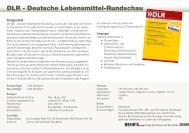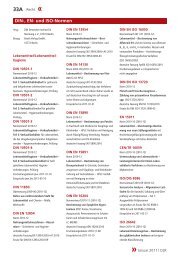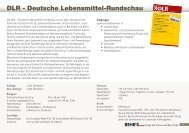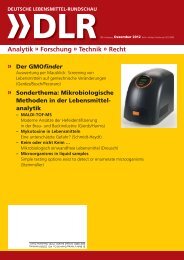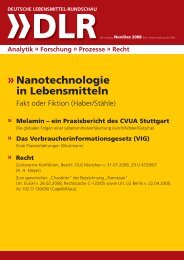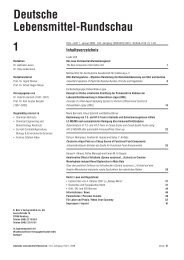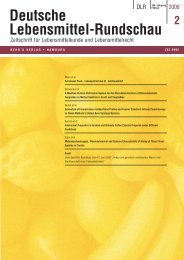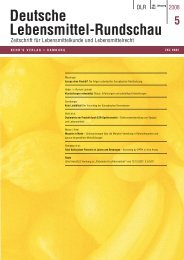Recht - DLR Online
Recht - DLR Online
Recht - DLR Online
Sie wollen auch ein ePaper? Erhöhen Sie die Reichweite Ihrer Titel.
YUMPU macht aus Druck-PDFs automatisch weboptimierte ePaper, die Google liebt.
pulse addition of yeast extract and magnesium sulphate was<br />
a suitable cultivation strategy to achieve high cell density<br />
culture for the industrial production of the biotherapeutic<br />
yeast S. boulardii.<br />
References<br />
Billoo AG et al.: Role of probiotic (Saccharomyces boulardii) in management<br />
and prevention of diarrhoea. World J Gastroenterol 12, 4557–4560<br />
(2006).<br />
Buts JP, De Keyser N, De Raedemaeker L: Saccharomyces boulardii enhances<br />
rat intestinal enzyme expression of endoluminal release of polyamines.<br />
Ped Res 36, 522–527 (1994).<br />
Buts JP, De Keyser N, Marandi S: Saccharomyces boulardii upgrades cellular<br />
adaptation after proximal enterectomy in rats. Gut 45, 89–96 (1999).<br />
Czerucka D et al.: Saccharomyces boulardii preserves the barrier function<br />
and modulates the signal transduction pathway induced in enteropathogenic<br />
Escherichia coli-infected T84 cells. Infection Immunity 68,<br />
5998–6004 (2000).<br />
Castagliuolo I et al.: Saccharomyces boulardii protease inhibits Clostridium<br />
difficile toxin A effects in the rat ileum. Infection Immunity 64,<br />
5225–5232 (1996).<br />
Castagliuolo I et al.: Saccharomyces boulardii protease inhibits the effects<br />
of Clostridium difficile toxins A and B in human colonic mucosa.<br />
Infection Immunity 67, 302–307 (1999).<br />
Cheng K-K et al.: Pilot-scale production of 1,3-propandiol using Klebsiella<br />
pneumoniae. Process Biochem 42, 740–744 (2007).<br />
Costa E et al.: The effect of nitrogen and carbon sources on growth of the<br />
biocontrol agent Pantoea agglomerans strain CPA-2. Lett Appl Microbiol<br />
35, 117–120 (2002).<br />
Del Piano M et al.: Probiotics: from research to consumer. Dig Liv Dis<br />
38, S248–S255 (2006).<br />
Elmer GW, Surawitz CM, McFarland LV: Biotherapeutic agents. A<br />
neglected modality for the treatment and prevention of selected intestinal<br />
and vaginal infections. JAMA 275, 870–876 (1996).<br />
Elmer GW, McFarland LV, Surawicz CM (Eds.): Biotherapeutic agents and<br />
infectious diseases. Totowa, N.J. Humana Press (1999).<br />
Elmer GW: Probiotics: “Living drugs”. Am J Syst Pharm 58, 1101–1109<br />
(2001).<br />
Fioramonti J, Theodorou V, Bueno L: Probiotics: what are they? What are<br />
their effects on gut physiology? Best Pract Res Clin Gastroenterol 17,<br />
711–724 (2003).<br />
ÜBERBLICK<br />
Paprika und Chillies<br />
Gewürze mit vielfältigen Eigenschaften<br />
Der Genus Capsicum gehört zur Pflanzenfamilie Solanaceae zu der<br />
auch Aubergine, Kartoffel, Tomate und die Tabakpflanze zählen.<br />
Von den bisher bekannten Capsicum-Arten (ca. 30) sind der größte<br />
Teil Wildpflanzen. Den genetischen Ursprung der Gattung Capsicum<br />
vermutet man in Südamerika, von dort aus hat sie sich weltweit verbreitet<br />
und wurde nach und nach domestiziert. Bei den Kultivaren<br />
(ca. 250) erschwert die Vielfalt die Artzuordnung, ja macht sie manchmal<br />
sogar unmöglich. Bevorzugt kultiviert werden Gewürzpaprika<br />
(Capsicum annuum L. var. annuum), Gemüsepaprika (C. annuum L.<br />
var. grossum Sendt.), Tomatenpaprika (C. annuum L. var. lycopersiciforme<br />
rubrum) und bei den Chillies-früchten, C. frutescens L., C.<br />
Guerra NP, Bernárdez PF, Castro LP: Fed-batch pediocin production on<br />
whey using different feeding media. Enz Microb Technol 41, 397–406<br />
(2007).<br />
Kadowaki S et al.: Effect of yeast extract on Endo-β-N-acetylglucosaminidase<br />
production by a Flavobacterium sp. Agr Biol Chem 52, 2105–2106<br />
(1988).<br />
Lin E-S, Chen Y-H: Factors affecting mycelial biomass and exopolysaccharide<br />
production in submerged cultivation of Antrodia cinnamomea<br />
using complex media. Bioresource Technol 98, 2511–2517 (2007).<br />
López JLC et al.: Production of lovastatin by Aspergillus terreus: effects<br />
of the C:N ratio and the principal nutrients on growth and metabolite production.<br />
Enz Microb Technol 33, 270–277 (2003).<br />
Mansour-Ghanaei F et al.: Efficacy of Saccharomyces boulardii with<br />
antibiotics in acute amoebiasis. World J Gastroenterol 9, 1832–1833<br />
(2003).<br />
Marten M, Seo J-H: A method for fractionation of cloned protein in recombinant<br />
Saccharomyces cerevisiae. Biotechnol Tech 3, 325–328<br />
(1989).<br />
Qamar A et al.: Saccharomyces boulardii stimulates intestinal immunoglobulin<br />
A immune response to Clostridium difficile toxin A in mice. Infection<br />
Immunology 69, 2762–2765 (2001).<br />
Park J, Floch MH: Prebiotics, probiotics, and dietary fiber in gastrointestinal<br />
disease. Gastroenterology 36, 47–63 (2007).<br />
Rigothier MC, Maccario J, Gayral P: Inhibitory activity of Saccharomyces<br />
yeasts on the adhesion of Entamoeba histolytica trophozoites to human<br />
erythrocytes in vitro. Parasitol Res 80, 10–15 (1994).<br />
Thomsson E et al.: Carbon starvation can induce energy deprivation and<br />
loss of fermentative capacity in Saccharomyces cerevisiae. Appl Environ<br />
Microbiol 69, 3251–3257 (2003).<br />
Wang Z, Da Silva N: Improved protein synthesis and secretion through<br />
medium enrichment in a stable recombinant yeast strain. Biotechnol Bioeng<br />
42, 95–102 (1993).<br />
Walker GM: The role of magnesium in biotechnology. Crit Rev Biotechnol<br />
14, 311–354 (1994).<br />
Walker GM, Maynard AI: Magnesium limited growth of Saccharomyces<br />
cerevisiae. Enz Microb Technol 18, 455-459 (1996).<br />
Zubillaga M et al.: Effect of probiotics and functional foods and their use<br />
in different diseases. Nutr Res 21, 569–579 (2001).<br />
Reiner Oberdieck<br />
Schwedensteg 12, D-95326 Kulmbach<br />
chinense Jacq. – eine verwandte, kultigene Form von C. frutescens<br />
L. – sowie C. baccatum L. var. pendulum (Willd.) Eshbaugh. Bekannte<br />
Kultivare von C. frutescens L. sind Tabasco (USA), Pi-quin (Mexiko)<br />
und Birds Eye (Afrika). Bei den Cayenne-Kultivaren findet man selten<br />
eine botanische Zuordnung, sie werden meist subjektiv nach ihrem intensiven<br />
und manchmal unerträglichen Scharfgeschmack bezeichnet.<br />
Es gibt da sicherlich Parallelen zu den „scharfen“ und unerträglichen<br />
Bedingungen in der ehemaligen französischen Strafkolonie gleichen<br />
Namens im Nordosten Südamerikas.<br />
Eine seltenere Kulturpflanze ist der Filzige Paprika (C. pubescens Ruiz<br />
et Pavon), der fast ausschließlich nur in Mittel- und Südamerika ange-<br />
428 ı Originalarbeiten Deutsche Lebensmittel-Rundschau ı 104. Jahrgang, Heft 9, 2008




